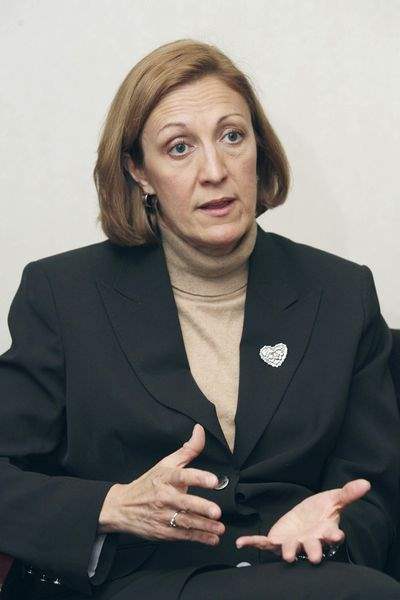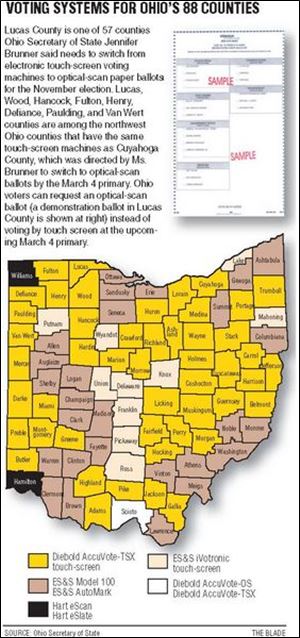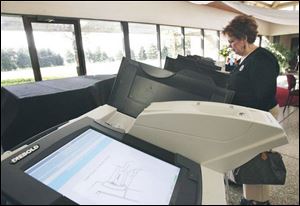
New voting machines mandated for Ohio
1/15/2008
Brunner
The Blade/Andy Morrison
Buy This Image
 Detailed info on counties to forgo touch-screens " rel="storyimage1" title="New-voting-machines-mandated-for-Ohio.jpg"/>
Detailed info on counties to forgo touch-screens " rel="storyimage1" title="New-voting-machines-mandated-for-Ohio.jpg"/>
<img src=http://www.toledoblade.com/assets/gif/TO17150419.GIF> VIEW: <a href=" /assets/pdf/TO36696115.PDF" target="_blank "><b>Detailed info on counties to forgo touch-screens</b></a>
Over the past few years, Lucas County spent more than $4 million to buy 1,613 Diebold touch-screen voting machines, but now Ohio's secretary of state wants those machines to be scrapped and replaced with optical scanners with paper ballots.
"If we have to pay, that would be a huge issue for us," county Commissioner Pete Gerken said. "It's unlikely we'd be able to spend five, eight, nine million on our own. We support having voting machines people believe in, and I think [Secretary of State Jennifer Brunner] understands local communities can't pay for it alone."
The issue surfaced first in Cleveland, with state officials determining that touch-screen voting machines used in Cuyahoga County were so unreliable that Ms. Brunner - the state's chief elections officer - ordered them dumped prior to the March 4 primary.
But the Diebold AccuVote-TSX, soon to be extinct in Cuyahoga County, will still be in use when Democrats and Republicans cast primary votes in Lucas, Wood, Fulton, Henry, Defiance, Hancock, Paulding, and Van Wert counties in the northwest portion of Ohio.
If Ms. Brunner gets her way, those counties and the 48 others throughout Ohio that have some version of touch-screen machines will discard them in favor of an optical-scan system for paper ballots in time for the November general election.
But local elections officials in northwest Ohio are fretting over her proposed machine swap, and are concerned over costs, logistics, and whether a change is even necessary.
"This has thrown us all in flux," said Dan Pilrose, deputy director of the Lucas County Board of Elections.

Carol Hayward of Whitehouse, voting in a May, 2007, election, uses one the 1,613 touch-screen voting machines recently purchased by Lucas County that the state now wants to replace.
Ms. Brunner, a Democrat, last month released the findings of a $1.9 million, state-commissioned study by academics and computer experts of Ohio's voting systems. Most of the touch-screen machines were purchased in the last couple of years with the help of about $100 million in federal funds.
The Ohio review raised serious security questions about the vulnerability of the touch-screen machines to hacking - with tools as small as a Treo smartphone and a magnet - and both human and computer errors, prompting Ms. Brunner to propose switching to paper ballots, consolidating polling places, centralizing vote counting, and allowing early voting by mail.
She also broke a 2-2 tie vote last month at the Cuyahoga County Board of Elections to replace the touch-screen machines by March 4, citing multiple computer software crashes that delayed the results of the Nov. 6 election as the reason for an immediate switch.
There have been numerous challenges to Ms. Brunner's directives, including from the American Civil Liberties Union, a non-partisan think tank from New York, elected Ohio leaders, and local elections officials, but she told The Blade last week that she still wants all counties now using touch-screen machines - including Lucas County - to switch to paper ballots.
"Just look at what's happened in Iowa and New Hampshire with the presidential primaries there," Ms. Brunner said. "Some of the presidential candidates are bringing new voters to the process, and they could swell voter turnouts here to 80 percent. We want to have the most trustworthy, secure voting system in place for an election of this magnitude."

Brunner
Ms. Brunner will try to sell Democratic Ohio Gov. Ted Strickland and state legislators on her directives in an informational meeting tomorrow, as some of them require a change in state law. She will also take part in similar meetings this week with local elections officials from around the state.
Among the questions she is sure to face is cost.
Ms. Brunner said the total cost of implementing all of her directives statewide would cost about $31 million, and the Cuyahoga County overhaul is expected to cost about $10 million by the November election.
Lucas County officials don't know what switching to optical-scan machines would cost - the county has 24 optical-scan machines in stock, compared to the 60 machines suggested for Cuyahoga County - but they do know the county doesn't have the money to pay for more equipment.
Ohio counties didn't have to pay for much - if any - of the switch to Diebold touch-screen machines, which Mr. Gerken and Lucas County Commissioner Tina Skeldon Wozniak said came at the order of then-Secretary of State Ken Blackwell after the 2004 election.
In addition to the $4.35 million in state and federal funds the county spent on new touch-screen machines for the November, 2005, election, commissioners purchased 68 additional touch-screen machines that year with $243,000 in county money, and another 10 machines for $27,000 in December, 2006.
Wood County has 538 touch-screen machines, and bought all but 50 of them with federal and state funds. Most of Fulton County's 164 Diebolds were purchased with federal and state funds, and all of Henry County's 106 touch screens were bought with $271,756 of federal and state money.
Ms. Brunner said she is keenly aware of the problem of unfunded mandates, and is seeking money to pay for her directives.
She hopes to secure funds from the $115 million to be distributed through the Help America Vote Act - a federal action that helped pay for most of Ohio's switch to touch-screen machines a few years ago - or from the state, perhaps through its $1 billion reserve fund.
But Governor Strickland is opposed to using Ohio's bailout fund to pay for new voting machines.
"The governor feels the rainy day fund was intended to be used to stabilize the state budget in times of emergency, and not for a purpose such as [purchasing voting machines]," said Keith Dailey, Mr. Strickland's spokesman.
The Fulton County commissioners said Ms. Brunner's directives will not be funded with county money, either.
The Fulton County Board of Elections asked the commissioners for $456,175 last week, to pay for new voting equipment and for Ms. Brunner's statewide directive for each county to provide paper ballots to voters who ask for them on March 4. The commissioners refused that request.
"Due to our tight budget this year, it's not prudent to incur any costs for new machines when the ones we have are working just fine," said Fulton County Commissioner Dean Genter, a Republican who added that the commissioners would revisit the issue if state lawmakers sign off on Ms. Brunner's plans.
Mr. Genter's attitude toward the performance of the Diebold touch-screen machines is shared by many elections officials in northwest Ohio.
Elections officials in Lucas, Wood, Henry, and Fulton counties all said they've had no major problems - security or egregious errors - with their touch -screen voting machines.
"This county has handled elections on this machine like Tom Cruise in Mission: Impossible," said Jill Kelly, executive director of the Lucas County Board of Elections. "I mean, every bell and whistle, every security measure, every detail, we've got it all down pat."
Ms. Kelly and many other elections officials said they're concerned with having to retrain poll workers on new machines, as well as the amount of time it will take to get election results by having to count paper ballots at a central location.
State legislators who will ultimately have to rule on Ms. Brunner's plans also question the move to optical-scan machines.
State Sen. Steve Buehrer (R., Delta) said in a released statement that he views Ms. Brunner's directives as an "expensive and rushed governmental flip flop."
"I don't believe there is strong enough evidence to suggest our current machines cause a significant problem versus what other states do," added State Rep. Randy Gardner (R., Bowling Green). "When anyone makes suggestions like this, the question is. 'Why?' The answer isn't clear."
Ms. Brunner said she's issued these directives because she has lost all confidence in touch-screen machines.
And voters' confidence, according to Ms. Brunner, the three Lucas County commissioners, who are all Democrats, and Mr. Gardner, is truly at the heart of the issue.
Ms. Wozniak and Lucas County Commissioner Ben Konop, like their counterpart Mr. Gerken, support Ms. Brunner's directives. They said elections - and voter confidence in the authenticity of those elections - are the "rock of our democracy."
Ms. Kelly, who runs the Lucas County Board of Elections office, said she is not opposed to Ms. Brunner's directives, but is concerned about their immediate impact.
She said the March 4 primary, in which a limited number of paper ballots will be on hand at each precinct for voters who have lost faith in touch-screen machines, could be a confusing and frustrating night in which the results of the election are not known until the next morning.
But more important, Ms. Kelly said, is that the voters are sure their votes counted.
"I just don't want voters to be afraid," she said. "We're doing everything humanly possible to provide top-level security for [the touch-screen machines]. Our machines are secure."
Contact Joe Vardon at: jvardon@theblade.com or 419-410-5055.